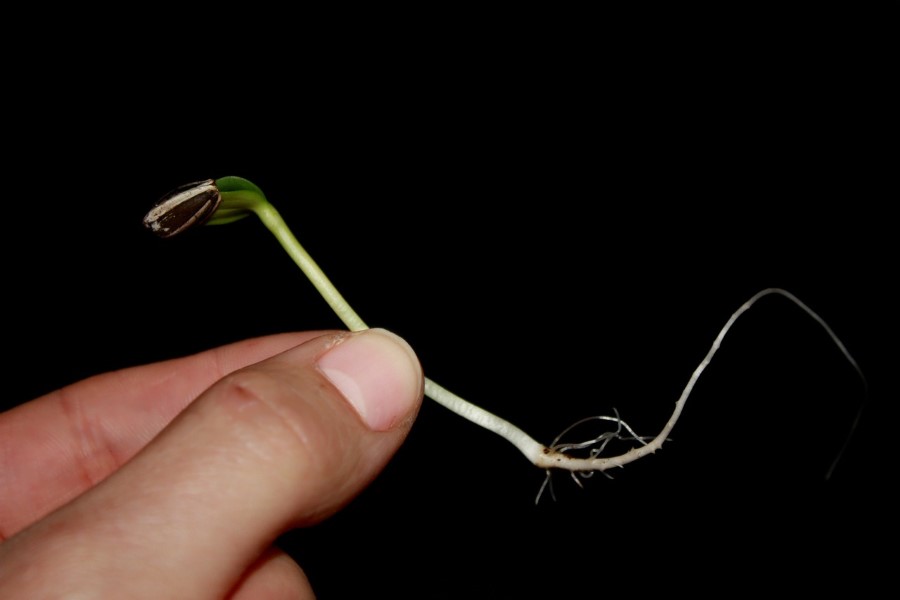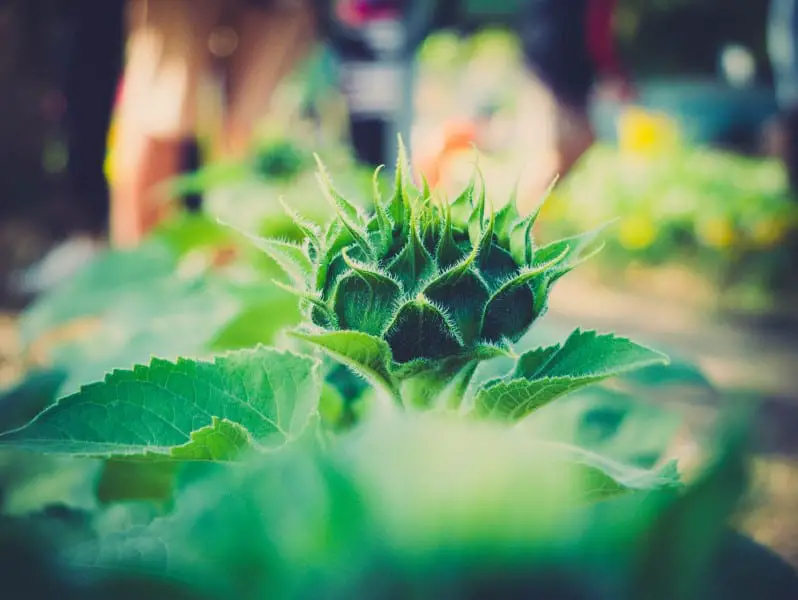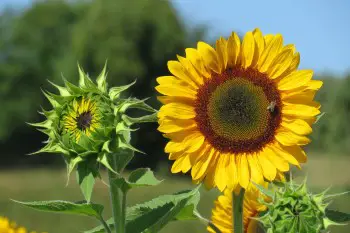Every year I love to grow sunflowers. They’re one of the fastest growing plants, and they also lend themselves to an education in the cycle of life and the facts of life. They also offer adventures with children and adults alike, as a competition for who can grow the tallest plant, to who can grow the biggest bloom.
Sunflowers are perfect to learn about the different stages of a plants growth and on how to keep a plant healthy from sowing the seed to harvesting the crop.
So what is a sunflowers growth timeline. Sunflower seeds grow into seedlings. Seedlings grow into strong plants. The mature sunflower grows buds that bloom. pollinators visit the blooms and seeds are formed. Seeds ripen and the sunflower begins to wilt. some of the Seeds fall from the flower, nestle in the ground, the cycle begins again.
My Sunflowers have been a novelty with the children in my family, I show them how to plant the seeds and keep the plant healthy till we harvest them.
They get a thrill at the rapid growth. This intrigues them and they get curious about more in depth questions too like how the sunflower get its energy to grow, how and why does it follow the sun and how it makes seeds.
There are over 70 varieties of sunflowers and so many colors to choose from. Annuals, perennials, dwarf, bush, multi headed and even seedless, but I am choosing the most iconic
Sunflower for this growth timeline and that is the iconic giant sunflower. The giant sunflower can grow up and over 6 feet tall and their flower heads are majestically large. By the way, if you can’t find the Giant sunflower locally, you can find it here on Amazon
I have based this general growth timeline observing the sunflowers I grow in my own garden. Depending on your growing conditions you might find a slight variation in some of the stages of growth.
So, let’s start at the very beginning...
8 Stages of Sunflower Growth (with chart)
Here is a list of stages, as a quick take away. below the list I’ve gone into more detail.
- Planting the Seed.
- Germination.
- The seedling, leaf and plant development.
- Growing a Bud
- Flowering.
- Pollination
- Seed development
- Harvesting
Stage 1. Planting the Seed.
Day 1.
Planting your seeds.
I usually plant the sunflower seeds I have carefully stored from my previous years harvesting. If you’re just starting out on your sunflower adventure then these seeds on are the ones I’ve based this sunflower timeline growth chart on. And I’ve written an ultimate guide on how to grow sunflowers here
The seed is the dormant undeveloped stage of the plant. This is where the life cycle is waiting to begin. The sunflower seed, with its shell on, is a single dried out fruit of a plant in its whole form. In botanical terms it is called a cypsela. Within this whole seed is all the nutrients and genetic information needed to grow another sunflower plant.
Stage 2. Germination.
2 to 10 days
After the seed has been planted germination starts to happen.
This is the first stage of the seeds awakened life. Underneath the soil, out of sight, the wispy roots reach out and a developing shoot pushes its way to the surface of the soil, looking for sunlight. When this shoot appears we know we’re on our way to growing a sunflower.
Stage 3. The Seedling, Leaf and Plant Development.
10 to 35 days.
Our seedling has become a young sunflower plant. This is its development stage to gain as much growth as it can.
If you have started your seeds off indoors then the time will come to harden them off and transfer them to their growing site outside. This usually happens towards the end of spring when the last of the harsh weather has gone.
The newly sprouted sunflower usually has 2 baby leaves on it and quickly grows many more as the stem starts to get taller. The first few sets of sunflower leaves are usually oval in shape but as more leaves come they look like the heart shaped leaves of a mature sunflower, only smaller.
The young plant starts to develop rapidly, getting as strong and tall as it can. sunflowers get energy through photosynthesis. You can find out how this amazing process works here.
Stage 4. Growing a Bud
35 to 65 days.
Our tall leafy maturing sunflower has grown big and strong enough to produce a bud.
Seeing buds on sunflowers is so exciting It means we’ve cared for our plant and hopefully we’ll reap the rewards of a flower, but we’re not quite there yet. Our sunflower plant is still growing and our bud is trying to get all the hours of sunlight it can in order to get as much energy for the bud to develop and enlarge.
The way our sunflower does this is by following the sun. It is a truly fascinating phenomena called heliotropism and I’ve written about this here
This is also the stage to keep your sunflower hydrated. Regular watering is so important for the budding and flowering stage of its life, so it can grow strong and big. If you need more details about watering I’ve written more information here.
Stage 5. Flowering.
65 to 85 days.
With all the care we have given our sunflower the bud has grown as big as it can and starts to flower.
Our sunflower has now reached its blooming stage and gently opens its petals. With all its glory it shows off to the world. We can enjoy this wondrous sight for a few weeks.
We’ve planted our sunflower to enjoy following their growth timeline but, if you so desired this is the time to display sunflowers indoors in a vase, by cutting a sufficient length of stem to do so.
Stage 6, Pollination
65 to 85 days.
Within the flowering stage Pollination takes place too.
In all its petaled gloriousness our sunflower welcomes pollinators to visit the thousands of nectar filled disc florets that are located within the large brown center circle.
The pollinators, mainly bees, sip on the nectar, while pollon gets stuck on their fluffy bodies. They transfer this pollen to another flower which starts the pollination and fertilization process.
Sunflowers pollinate in the usual two ways, but they also have a mysterious fail safe mechanism to ensure pollination and fertilisation does happen. I’ve written about this amazing and wonderful fact here. 
Stage 7. Seed Development
85 to 105 days.
After pollination the fertilized seeds start to develop and ripen.
This stage of our sunflower is fascinating in itself. The main object of its whole life cycle has come to this, producing as many healthy seeds as it can. The back of the sunflowers head starts to turn yellow, this is perfectly natural tells us that the seeds are ripening. This process could last up to 125 days depending on the variety and conditions.
The ripening seeds attract birds, animals and bugs to feast on. Watching these critters enjoy my sunflowers is a guilty pleasure of mine. it also acts as an education for children to spot different species of wildlife visiting your sunflower patch.
This stage is ideal to decide whether to harvest or not.
Stage 8. Harvesting
105 to 125 days.
The ripened seeds are ready to harvest.
At this stage the sunflowers head starts to droop and turn brown. If you have decided to harvest the seeds for feeding your pets, or yourself, or to store for winter feed for the wildlife, then this will be a good time to do so. You can do this by cutting the stem about 4 inches below the sunflowers head, store it upside down in a breathable bag in a dry place away from wildlife and pets.
If you’ve grown your sunflower for the wildlife to enjoy and a nifty creature hasn’t eaten all of the fallen seeds, then maybe the seeds might nestle in the undergrowth where they stay dormant for the winter.
Then, come the warmth of the following spring the seeds wake up, they start to germinate and a sunflower seedling will appear, and we can once again marvel in the 8 wonderful stages of our sunflowers growth timeline.
Sunflower Timeline Growth Chart
The chart below represents a visual representation of the 8 Sunflower Growth Timeline stages as a quick reference guide for you. I hope it helps
My Conclusion
I hope this has been helpful and a fascinating read to you as it has been for me to write. I bimble about my garden enjoying the fruits of my labour and sometimes take for granted the marvels of mother nature. She nurtures the seeds I plant at the beginning of the spring, for a harvest by the late summer.
Writing this has made me realise the awe I have for how my sunflowers grow. The time it takes and the way they use every opportunity to get the best from their environment, without impacting on it. And at the end of their timeline they give back what their growth has produced.
Related Questions
When do sunflowers bloom? For an annual giant sunflower to bloom, It’s usually about 120 to 180 days after being sown (17 to 26 weeks). But This can vary for all the different varieties in the world and The condition you grow them in.
No two sunflowers are the same, not even if the seeds come from the same plant. In fact, not all sunflowers are sunflowers! If you want to know when they will bloom in your part of the world then check out our table here
How much does a sunflower grow in a week? Sunflowers are a very fast growing plant. Their development depends on the condition you grow them in, and the care they’re given. Because they’re fast growing, growth is so variable for each one, but interesting to measure the growth of your own sunflower week by week.
Check the packet on your seeds to see how tall the sunflower is expected to grow. Then to find an average of growth per month, divide that height over the period, allowing about a month at the end when it no longer grows or just focuses on blooming.
So for example over a 5 month growing period from planting to the start of blooming, you can expect a 6 foot variety of sunflower to grow around 8-10 inches (20-25 cm) per month. Then divide approximately by 4 (approx) to arrive at the sunflower growth per week.
What time of year do sunflowers bloom? The tall single giant headed varieties usually bloom towards late summer and last for 2 to 3 weeks. The smaller and multi headed varieties, perennials too, can start blooming at the beginning of summer and if deadheaded regularly they will keep flowering throughout the summer months.
All illustrations by Pamela-Anne, and are the property of shesaidsunflower.com


How soon can I plant seeds that have fallen from the plant? For example, I harvested my seeds in late September. Do I have to wait to plant til next spring?
Yes, I’d wait until next spring. Otherwise, they may not grow due to the cold.
Hi Pamela my name is Matthew and I am intern at the Arboretum in Flagstaff, AZ. I am currently working on a project creating an interpretive kiosk talking about phenology and the timeline you have illustrated of the growth of sunflowers is a great illustration and would love to use it for the project I am currently working on. I hope you’re okay with me using it for my project.
Thank you Matthew. I’m delighted that you’ve found my sunflower growth timeline illustration of help to your work. I would only ask that you add a citation, then feel free to use it. good luck with your project. 🙂
This is a wonderfully helpful article. My daughter wants to wed in a sunflower field – in April. The good news is we live in coastal Texas and I’m willing to start plants indoors. We are test planting a range of sunflower varieties to track their days to bloom and decide when we will need to start them indoors to be ready for her wedding day April 17th 2020.
This is ambitious, I know. Any advice would be greatly appreciated.
Hi Sasha, It sounds like you’re doing everything right, and within your power to make your daughters sunflower wedding a day to remember. I based the timeline article on sunflowers that grow to 6-8 feet tall, such as the Giant Russian, Tall Single, and Titan, and in the ideal climate and growing condition. Unfortunately, it’s not an exact science so, if you have the means to sow large amounts of seeds, indoors every two weeks (starting five months before your daughter’s wedding) get every sown batch hardened off and planted out, being careful of low temperatures, as this may kill them off. The only solution I can think of to protect them and acclimatize them further when planting out, would be to use something like this tunnel. I hope all goes well and that you have a field of sunflowers blooming at the right time. Best wishes with this, and your daughter’s wedding. x
Emmm, if the first 2 leaves turn their heads down and died, does it mean this one not developing well and will die soon?
what to do with this situation?
Only Day 17, transplanted 5 days ago 🙁 got 6 leaves in total already…..
Firstly Emeline, well done in getting your sunflowers started and transplanted. The first few sets of sunflower leaves usually do turn yellow, wither and droop. And you might find as the plant grows taller, more of the lower leaves keep drooping too. This is because the energy of the sunflower is being directed to the top of the plant, so it can grow tall and strong to support the bud, bloom and then create seeds. Please don’t worry, this is normal. 6 leaves sounds like they’re growing great. x
How would you deal with bugs and insect eating the sunflowers?
Thanks Jack, good question, Thankfully, not all the bugs that visit sunflowers would be eating them, many are friendly bugs. In general there’s a few ways you can deal with them. The first being environmentally friendly, use barriers such as netting. A mild solution of water and detergent to wash the affected areas could help. Or alternatively, you could use store-bought pesticides to stop bugs eating your plants. Always remember to wash your seeds once harvested. hope that helps 🙂
it is really help me my PPT presentation
Thank you for your comment Satyam
I’m so pleased this article helped with your presentation 🙂
I’m so glad I found your article! I’ve been researching sunflowers like crazy for my wedding in August. I’m trying to find information on the optimal time to plant various sunflower varieties, in eastern Canada for gorgeous blooms in late August. Any suggestions?! Thanks!!
Hi Kim,
First of all, congratulations on your up and coming wedding 🙂
And thank you for your lovely comment.
I’m sending you an email with more details about the points I’ve written below. I hope this helps towards your special day.
First, decide on the variety of sunflowers you want for your wedding from my article 31 Most Wonderful Sunflowers to Grow
Then, go to this article that gives you a detailed guide on How to Grow Sunflowers
Youll find these articles helpfull towards caring for your sunflowers as they grow and any problems that may arise.
Why are My Sunflowers Drooping
Do Sunflowers Need a Lot of Water
I hope these suggestions help with your special sunflower wedding 🙂 x